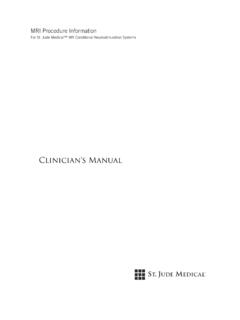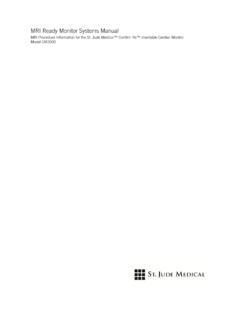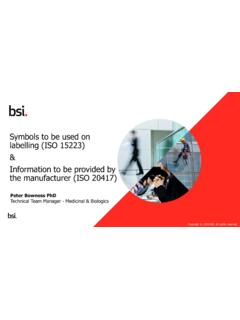Transcription of User's Manual - St. Jude Medical Instructions for Use Website
1 Confirm Rx . Model DM3500. Insertable Cardiac Monitor User's Manual Unless otherwise noted, indicates that the name is a trademark of, or licensed to, St. jude Medical or one of its subsidiaries. ST. jude Medical and the nine-squares symbol are trademarks and service marks of St. jude Medical , Inc. and its related companies. Pat. 2016 St. jude Medical , Inc. All Rights Reserved. Description This Manual describes the following St. jude Medical device: Table 1. Confirm Rx insertable cardiac monitor Name Model Number Description MRI Status Confirm Rx DM3500 Insertable cardiac MR Conditional monitor The St. jude Medical Confirm Rx insertable cardiac monitor (ICM) is designed to detect arrhythmias and wirelessly transmit data to the Patient Care Network (PCN). The ICM constitutes the inserted portion of the system. The Merlin Patient Care System (PCS) with software version (or greater), magnet, myMerlin mobile application (app), and PCN.
2 Constitute the external portion of the system. The Merlin PCS and magnet are used to interrogate and program the device in the clinic. Remote transmissions are performed using the app. The app also allows patients to record and send EGMs of symptomatic events to the clinic. All remotely transmitted data is made available on where clinicians can log in, review data, and make a diagnosis. 1. Indications for Use The Confirm Rx ICM is indicated for the monitoring and diagnostic evaluation of patients who experience unexplained symptoms such as: dizziness, palpitations, chest pain, syncope, and shortness of breath, as well as patients who are at risk for cardiac arrhythmias. It is also indicated for patients who have been previously diagnosed with atrial fibrillation or who are susceptible to developing atrial fibrillation. Table 2. Accessories and their intended uses Accessory Intended use Incision tool Cut the skin during the insertion procedure Insertion tool Deliver the device into the insertion channel Magnet Initiate a programmer session when placed over the device Magnetic Resonance Imaging (MRI).
3 The Confirm Rx ICM is conditionally safe for use in the MRI environment when used according to 2. Instructions in the MRI Ready Monitor Systems Manual . Contraindications There are no known contraindications for the insertion of the Confirm Rx ICM. However, the patient's particular Medical condition may dictate whether or not a subcutaneous, chronically inserted device can be tolerated. Warnings and Precautions Sterilization The device and the incision and insertion tools have been sterilized with ethylene oxide prior to shipment. They are intended for single use only and should not be resterilized. If the sterile package has been compromised, contact St. jude Medical . Do not insert the device if the dot on the ethylene oxide label is purple. Purple indicates that the package has not been sterilized. Return the device to St. jude Medical . Package Inspection Check the "use-before" date on the package label. Do not insert the device if its "use-before" date has expired.
4 Do not use the device if the packaging is wet, punctured, opened or damaged because the 3. integrity of the sterile packaging may be compromised. Return the device to St. jude Medical . Storage Store the device in a clean area. Store the device between -20 and 60 C because temperatures outside this range may damage the device. After cold storage, allow the device to reach room temperature before programming or inserting the device because cold temperature may affect initial device function. Insertion Insert the device in the subcutaneous space, just under the skin. Place the device no deeper than 2 cm to ensure reliable data transmission. Device Replacement Replace the device within one month of receiving a low battery alert, if necessary or desired. Replace the device immediately upon receiving a low battery alert if frequent EGMs are being stored and remotely transmitted. Explant and Disposal Interrogate the device and turn monitoring off before explanting, cleaning or shipping the device to prevent unwanted EGM and episode storage.
5 Explant the device with standard surgical tools upon receiving an EOS alert. 4. Return all explanted devices to St. jude Medical . Never incinerate the device because of the potential for explosion. Explant the device before cremation. Environmental and Medical Therapy Hazards Instruct patients to avoid devices that generate a strong electric or magnetic interference (EMI). EMI could cause device malfunction or damage, resulting in inappropriate episode storage or inhibition of episode storage. Moving away from the source or turning it off will usually allow the device to return to its normal mode of operation. Hospital and Medical Environments Electrosurgical cautery may cause device malfunction or damage. If electrocautery is necessary, keep the current path and groundplate as far away from the device as possible. External defibrillation may damage the device. Minimize current flowing through the device by following these precautions when using external defibrillation on a patient with a device: - Position defibrillation paddles as far from the device as possible (minimum of 13 cm).
6 - Use the lowest clinically appropriate energy output - Confirm the device function following any external defibrillation Do not direct high radiation sources such as cobalt 60 or gamma radiation at the device. If a 5. patient requires radiation therapy in the vicinity of the device, place lead shielding over the device to prevent radiation damage and confirm its function after treatment. Lithotripsy may permanently damage the device. Avoid it unless the therapy site is not near the device. Avoid diathermy, even if the device is programmed off, as it may damage tissue around the device or may permanently damage the device. The device should not be exposed to therapeutic levels of ultrasound energy, as the device can inadvertently concentrate the ultrasound field and cause harm that might not be immediately detectable. Diagnostic ultrasound treatment is not known to affect the function of the device. Transcutaneous Electrical Nerve Stimulation (TENS) may interfere with device function.
7 To reduce interference, place the TENS electrodes close to one another and as far from the device as possible. Monitor cardiac activity during TENS use. Radiofrequency (RF) ablation in a patient with a device may cause device malfunction or damage. Minimize RF ablation risks by: - Disabling monitoring - Avoiding direct contact between the ablation catheter and the inserted device - Positioning the groundplate so that the current pathway does not pass near the inserted device, , place the groundplate under the patient's buttocks or legs 6. Home and Occupational Environments High-voltage power transmission lines may generate enough EMI to interfere with device operation if approached too closely. Communication equipment such as microwave transmitters or high-power amateur transmitters may generate enough EMI to interfere with device operation if approached too closely. Home appliances in good working order and properly grounded do not usually produce enough EMI to interfere with device operation.
8 There are reports of device disturbances caused by electric hand tools or electric razors used directly over the device insertion site. Wireless communication devices such as computers that operate on a wireless network, cellular phones, smart phones, tablets, and even cordless telephones may generate enough EMI to interfere with device operation. A variety of industrial equipment produce EMI of sufficient field strength and modulation characteristics to interfere with proper operation of the device. These include, but are not limited to: arc welders; induction furnaces; very large or defective electric motors; and internal combustion engines with poorly shielded ignition systems. Electronic Article Surveillance (EAS). Advise patients that the Electronic Article Surveillance/Anti-theft (EAS) systems such as those at the point of sale and entrances/exits of stores, libraries, banks, etc., emit signals that may interact with the device.
9 It is very unlikely that these systems will interact with their device significantly. 7. However, to minimize the possibility of interaction, advise patients to simply walk through these areas at a normal pace and avoid lingering near or leaning on these systems. Metal Detectors Advise patients that metal detector security systems such as those found in airports and government buildings emit signals that may interact with their device. It is very unlikely that these systems will interact with their device significantly. To minimize the possibility of interaction, advise patients to simply walk through these areas at a normal pace and avoid lingering. Even so, the device contains metal that may set off the airport security system alarm. If the alarm does sound, the patient should present security personnel with their patient identification card. If security personnel perform a search with a handheld wand, the patient should ask that they perform the search quickly, stressing that they should avoid holding the wand over the device for a prolonged period.
10 Mobile devices The device has been tested for compatibility with handheld wireless transmitters in accordance with the requirements of ISO 14117:2012. This testing covered the operating frequencies (450 MHz - 3 GHz) and pulsed modulation techniques of all of the digital cellular phone technologies in worldwide use today. Based on the results of this testing, the device should not be affected by the normal operation of cellular phones when used more than 15 cm from the device. To minimize the possibility of interaction, advise patients not to carry a cellular phone in a breast 8. pocket or on a belt within 15 cm of the device, and to use a cellular phone on the side of their body opposite from the device. Potential Adverse Events Possible adverse events (in alphabetical order) associated with the device, include the following: Allergic reaction Bleeding Chronic nerve damage Erosion Excessive fibrotic tissue growth Extrusion Formation of hematomas or cysts Infection Keloid formation Migration 9.
![Tendril STS 2088 [OUS] - St. Jude Medical Instructions for ...](/cache/preview/0/1/6/5/9/9/f/b/thumb-016599fbc524e50a7f361018615dac17.jpg)














